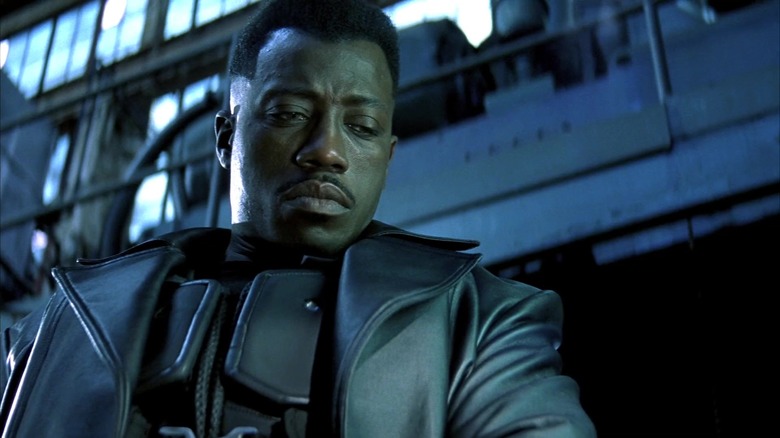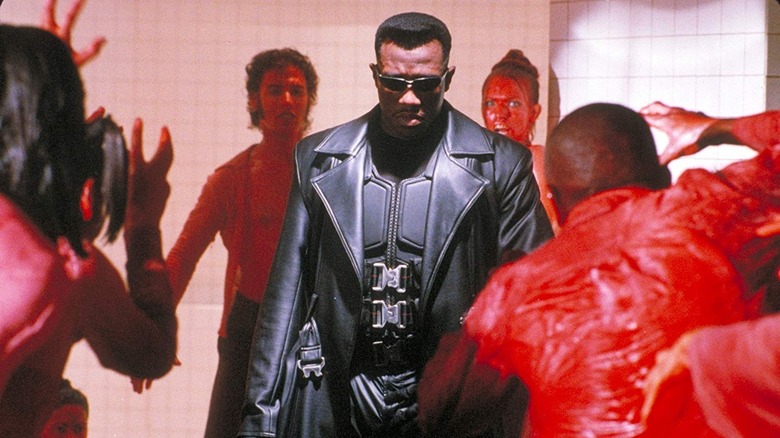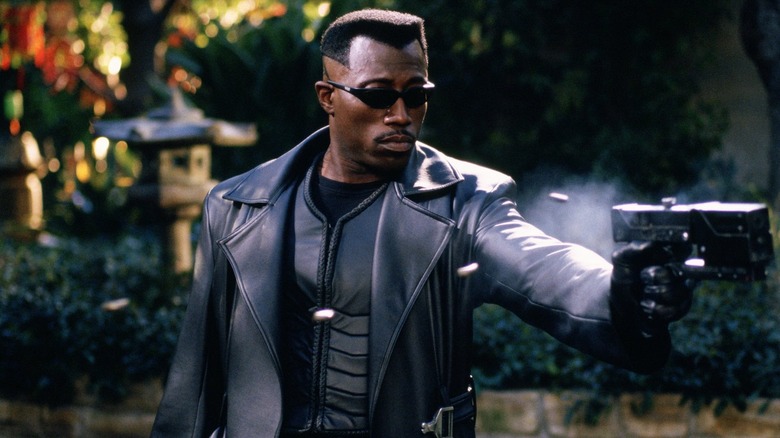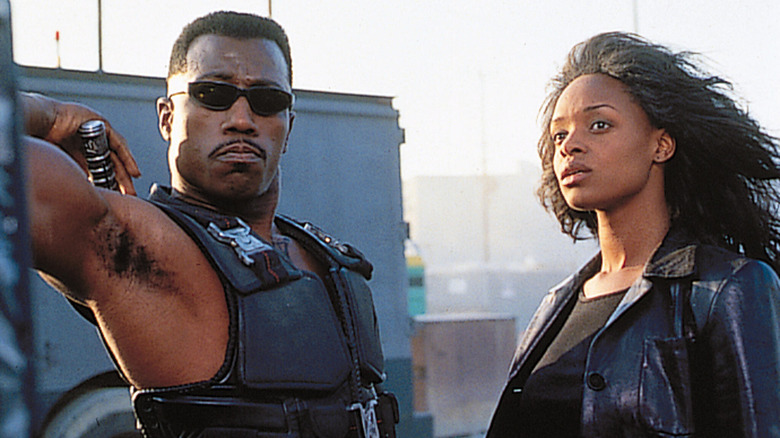25 Years Ago, Blade Was A Great Comic Book Movie Before Comic Book Movies Were Cool
In the Marvel vs. DC debate, it's important to remember that the latter had a headstart of several decades. Some of DC Comics' most popular characters were introduced on the page in the late 1930s and early 1940s, allowing them to stand at the very base of the pop culture firmament. Superman, Wonder Woman, and Batman both enjoyed massive success on the page and on the screen before the hotshot company Marvel entered its Golden Age in earnest. Marvel's star characters Spider-Man, the X-Men, the Fantastic Four, the Incredible Hulk, et al, didn't hit shelves until the early '60s. While Marvel found its footing, Batman was starring in one of the best superhero movies ever made.
In cinemas, it took Marvel equally long to find a toehold. Films like "Superman" and "Batman" were overwhelmingly huge for decades, while Marvel had to be content with the success of "The Incredible Hulk" on television. 1986's "Howard the Duck" was a notorious bomb, and some Marvel fans may have seen Oley Sassone's notoriously cheap 1994 film "Fantastic Four" ... which was never officially released. It wasn't until the Man of Steel petered out with "Superman IV: The Quest for Peace" and Batman crashed into the ground with 1997's "Batman & Robin" that DC's ascendency in theaters drifted slowly to the ground.
By then, it was the '90s and everything was edgy and self-aware. Beavis and Butt-Head commented on MTV videos and "Mystery Science Theater 3000" blended comedy and criticism. It was the age of deconstruction.
In this milieu, superheroes could not be bright and traditional. They had to be violent and edgy. They had to live in stylized universes (see: "The Crow"), or they had to be ultra-cool, black-clad sword warriors at a vampire rave.
Enter Stephen Norrington's 1998 film "Blade."
The coolest man on the planet
Watching it 25 years after its release, one will find that "Blade" is terribly dated. Its aggressive ultra-techno was abandoned on the alkali flats of pop culture long ago, and its black leather trench coats are most decidedly out of fashion. Also no longer hip is star Wesley Snipes' stoic unflappability; in the '20s, superheroes tend to be wisecracking Tiktok celebrities who quip and mug and want people to look at them. Blade, like all the coolest '90s kids, was apathetic to your attention. And that's what made him cool.
Also unlike much modern superhero cinema, "Blade" was rated R. The film begins with the title character — a half-vampire badass — infiltrating a vampire rave attended by Traci Lords (!). While the vampires lose themselves to the music, showerheads installed in the ceiling spray hundreds of gallons of human blood onto them. They writhe in ecstasy, lost in the sensual pleasure of it all. It's then that Blade breaks it and proceeds to slice up the undead monsters with swords, knives, and other bladed throwing weapons. He is a warrior of the night, eager to keep the city's vampire population in check.
The mythology of "Blade" is fun: it seems that vampires not only live among us, but they are generally in charge of most major industries. The vampires, led by Udo Kier (natch), meet around long boardroom tables to discuss their vampire business. They have their own written language, their own bibles, their own archivists. They have armies of human familiars who look after their affairs during the day.
They also feed on humans, an act that Blade cannot abide by. His own mother, you see, was bitten by a vampire when she was pregnant with him.
The glorious, glorious violence
"Blade" sought to demystify vampires, depicting them as boring suits, or — in the case of its villain, Deacon Frost (Stephen Dorff) — whiny "new money." Vampirism was spoken of like a virus, and killing vampires had chemical, biological solutions. One might be tempted to draw a parallel between the vampirism in "Blade" to anxiety about AIDS, but the metaphor doesn't quite hold up. More palpable is the notion that Kier plays an elder member of the queer community who remembers the AIDS crisis and wants to behave cautiously in the world, while Dorff is the crass, incautious young a-hole who thinks the crisis is now over.
"Blade" came only a few years after Neil Jordan's "Interview with the Vampire," which sold Nosferatus as wig-wearing, ultra-sexual romantic fops. "Blade" turned vampires into squishy bags of skin. Indeed, Norrington's film started an unfortunate trend in vampire cinema; the exploding vampire. When stabbed or staked, all vampires now melted into a pile of CGI ash.
The 1998 version of Blade was lifted from a recent trend in Marvel Comics toward Goth-friendly angst. Marvel was chasing shadowy trends started by books like "Sandman," "Death," and, well, "The Crow" when they launched their "Midnight Sons" imprint in 1993, gathering all their demonic heroes under one banner. Ghost Rider, Morbius the Living Vampire, the Darkhold Redeemers, and Blade all began interacting more heavily, fighting Lilith and other otherworldly Hellspawn. Many of these characters, including Blade, were repurposed from their introductory periods in the 1970s (notably, when Satanic Panic was riding high).
The Snipes version of Blade was born of Marvel's darkened trends. While "The Crow" was on the Joy Division end of Goth spectrum, Blade was closer to New Order.
What it began
"Blade" was a modest success, feeding into movie trends at the time. Many of the film's fans didn't care — or perhaps even know — that Snipes was playing a character from Marvel Comics. To certain executives, however, Marvel started to look alluring. A few years later, Bryan Singer made "X-Men," a bigger-budget, more high-profile superhero film that followed in the steely black-leather aesthetics of "Blade." That same year, Artisan Entertainment landed a plum contract, purchasing multiple Marvel superheroes for a song. Marvel Comics was in trouble at the time and was eager to sell off the film rights to their characters to any takers. Artisan, Marvel fans might know, had plans in 2000 to make movies based on Captain America, Thor, Deadpool, Iron Fist, Morbius, Longshot (an X-Men character), the Power Pack, and Mort the Dead Teenager.
As we all know now, those characters all scattered and landed at other studios. Apologies to fans of Longshot, as his film never manifested.
After the success of "X-Men," and Sam Raimi's "Spider-Man" the following year, Marvel superheroes were now catching up to the cinematic heyday of DC. At the end of the '00s, the studios sifted down through heroes like Daredevil and the Hulk to find Iron Man. They struck gold. The next 15 years would be all superheroes all the time, and the phrase "cinematic universe" entered the popular lexicon. 30-some films later, "Blade" will be folded back into the MCU, now living in the same universe that Iron Man once did.
"Blade" turned out to be the proof-of-concept for the following few decades of pop entertainment. The techno fashions may be out of date, and the CGI may not look good (golly, no!), but the film still possesses the ability to thrill and astonish. "Blade," even 25 years later, is still cool.



